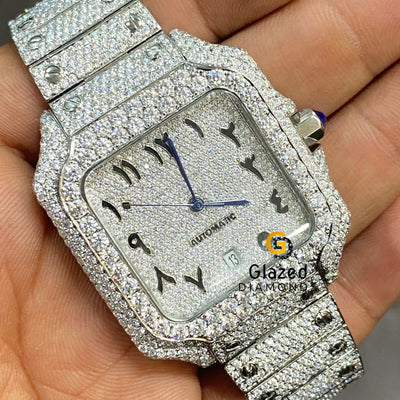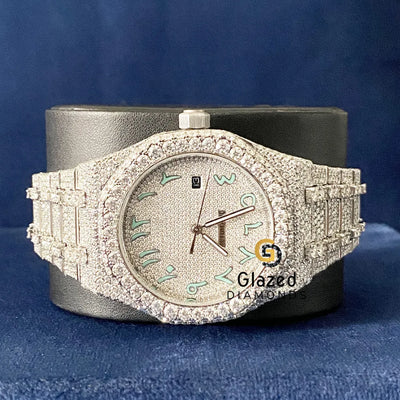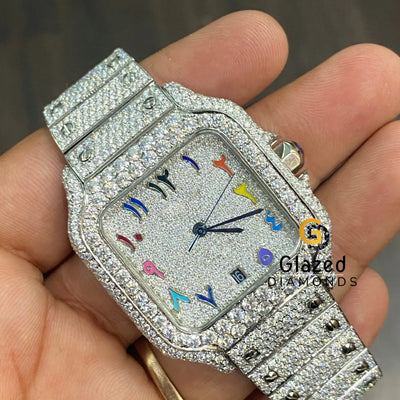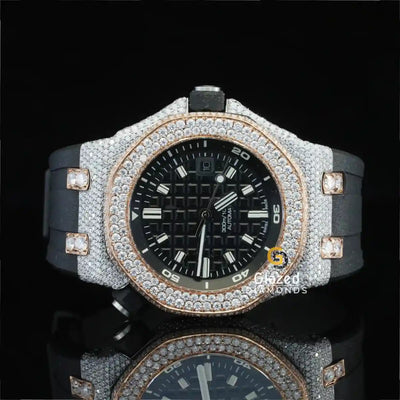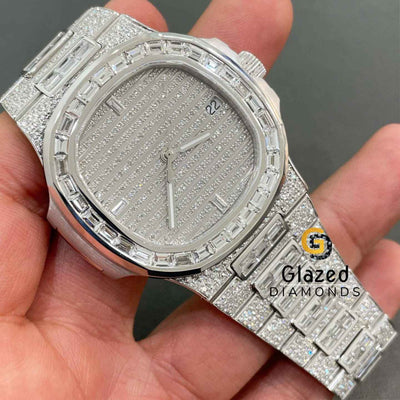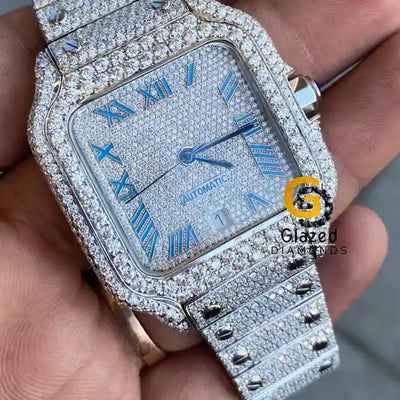Picking the best metal setting for moissanite is about two things. Keep stones safe and keep the bezel bright under flat glass. The right metal and setting style decide comfort, service ease, and how clean the circle of light looks in photos.
Let's get to know more about the best metal setting for moissanite watches!

316L Stainless Steel: The Everyday Winner
316L is the calm default for watch cases and bezels. It resists corrosion, takes a high polish, and works well with bead or channel settings. The color is a neutral silver that lifts moissanite’s brightness without harsh glare. Service is easy. Prongs hold shape. Beads can be tightened cleanly. If you want daily comfort and simple care, start here.
904L Stainless Steel: Brighter Finish, Higher Care
904L polishes to a slightly whiter tone than 316L. That extra flash makes bezels pop in store light and under LEDs. It also asks more at the bench. Tools must stay fresh and clean to avoid scratches during setting or repair. If you love a bright, luxe sheen and plan occasional polishing, 904L delivers a premium feel.
Titanium Grade 5: Light on Wrist, Strong in Use
Titanium cuts case weight without killing presence. Grade 5 holds detail better than pure grades and pairs well with secure channel settings and recessed bead rows. Color is a cool gray that makes moissanite fire read modern. The bench needs carbide tools and gentle heat control. If long events tire your wrist, titanium keeps comfort high.
Pvd Gold Over Steel: Warm Tone With Real-World Durability
Physical Vapor Deposition over 316L gives a thin, hard gold layer that resists wear better than old platings. Yellow adds warmth and softens moissanite’s fire. Rose reads romance and pairs well with smaller stones. Choose PVD over basic plating for bracelets and bezels you plan to wear often. Ask for thickness specs in microns so you know the coating is not just for show.
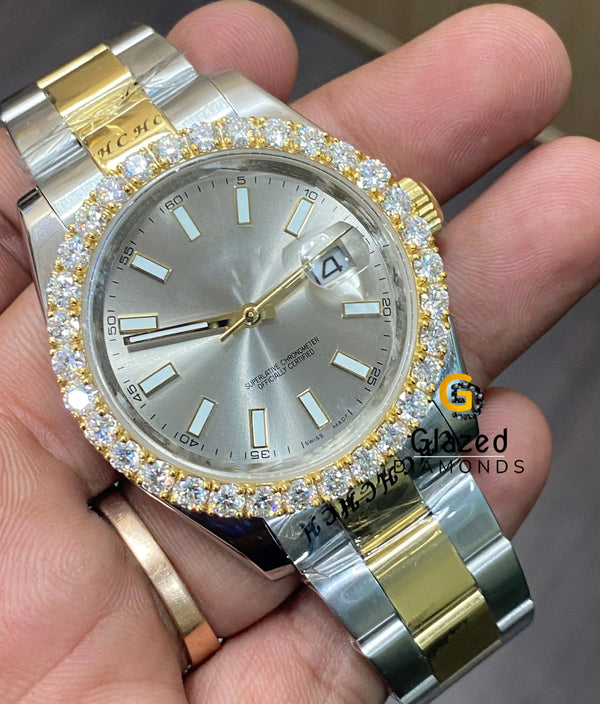
Solid Gold Accents: Best as Bezel Rings and Index Frames
Full solid gold cases look great yet add weight and cost. A smart compromise is a steel case with a solid gold bezel ring or gold index frames. The warm tone calms flash and photographs well. Use tight bead work so prongs stay low and do not snag sleeves. If you love gold but want practical service, mixed builds make sense.
Ceramic and Steel Hybrids: Scratch Resistance With Crisp Contrast
Ceramic bezel inserts resist scratches and hold color. Pair them with steel for structure and use moissanite in steel windows or rings that interrupt the ceramic. The contrast is sharp. Just avoid high, exposed prongs on ceramic edges. Channel windows and flush seats are safer and still read premium.
What to Avoid or Use With Care

Soft Base Metals
Skip cases or bezels built with soft base metals. They bend during setting and lose tension fast. Stones can loosen after a few weeks, and tightening becomes a cycle. You also see dents near crown guards and clasp points that spoil clean lines.
Low-grade Plating
Low-grade coatings rub away at bracelet corners and crown guards. Edges turn patchy, which makes bright moissanite look out of place. If you want a gold tone, ask for PVD with stated thickness in microns. That small spec protects shine and reduces service.
Sterling Silver for Daily Watches
Silver tarnishes and feels soft in this use. Daily sweat and sleeve rub add marks that grow fast. It suits dress pieces worn rarely, not an everyday set bezel. If you love the color, keep it for accents, not the main case.
Tungsten Prong Work
Tungsten is very hard and also brittle, and it chips tools and resists tidy bead tightening. Prongs can crack during small corrections. Use tungsten for plain rings if you must, not for gem seats that need fine adjustments.
Setting Styles That Work Best
-
Channel: Stones sit between solid metal walls for a straight, secure track. Ideal for baguettes and markers, and a bench can tighten it without touching nearby links.
-
Bead-set pavé: Tiny beads hold uniform rounds in a smooth halo. Keep beads small and even so the bezel reads as one calm ring of light.
-
Micro-prong: Best for larger rounds on thicker bezels. Prongs must sit low and smooth so sleeves glide and grip stays strong.
-
Flush windows: Stones sit in countersunk holes, then edges burnish over for a slick seat. Durable and sleek for crowns and lugs with easy cleaning.
Practical Buyer Checks You Can Do Fast

-
Stone seating: Run a fingernail around the bezel. It should glide without catching.
-
Color harmony: Step under the LEDs and a window. The circle should read as one tone.
-
Prong honesty: Prongs must be even and low. No sharp tips.
-
Bracelet balance: A set bezel adds visual size. Check lug-to-lug so the watch sits flat.
-
Service plan: Ask how beads tighten and what cleaning method the shop recommends.
Care That Keeps the Bezel Bright
Use warm water, mild soap, and a soft brush. Work the underside of the bezel, where lotion hides. Pat dry with a clean microfiber. For PVD and polished 904L, avoid abrasive cloths. Schedule a seasonal check for bead tension and crown seals.
Quick Picks by Use Case

-
Daily wear, set once and enjoy: 316L steel with bead-set pavé.
-
Lightweight travel and long events: Titanium with channel-set baguettes.
-
Warm formal nights: 316L case with PVD yellow bezel and small rounds.
-
Scratch-aware jobs: Steel case with ceramic insert and moissanite in steel windows.
Final Thoughts
The best metal setting for moissanite keeps stones secure, reads clean in mixed light, and makes service simple. 316L is the everyday winner. 904L adds sheen, while titanium cuts weight.
PVD gold brings warmth without fussy upkeep. Match that metal to a tidy channel or bead set, and your bezel will glow for years without drama. If you want a short list tailored to your wrist and your venue plan, Glazed Diamonds can help you pick the right build and set it with care.





